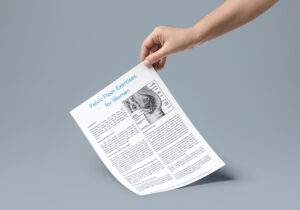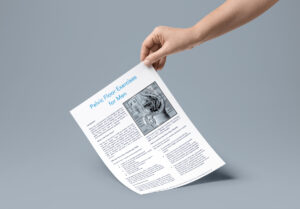Incontinence Myths
Published on 23/02/21
By Gail Ford-Rowley, Registered Nurse
AD This Article Contains Links
For such a common condition as incontinence, it’s important to understand exactly what help and support is available. But also, what common myths and misconceptions to avoid as these may prevent you from properly managing your incontinence.
We receive an overwhelming response from our members with questions they needed confidential help with. It seems even more important now, with us all limiting contact with our local GP, family and friends. So, we asked the HARTMANN nurse advisors to dispel some of the myths and give their advice for incontinence sufferers.
Myth 1: “Drink less to prevent urinary incontinence”
People always think they should drink less to prevent urinary incontinence. Unless you have received specific advice from a healthcare professional to have restricted fluids, this is a common myth and sufferers should continue drinking fluids as normal.
Many sufferers think that by limiting how much they drink; it will reduce or prevent the amount of urine they pass. Unfortunately, this is not the case, limiting fluids can make the problem worse. Less fluid leads to urine becoming more concentrated, irritating the bladder, and making the problem worse. Urine should be straw colour, too much fluid and urine will look transparent, too little water and urine will look dark orange so it’s important to always maintain a middle ground. In addition, some fluids such as caffeine, fizzy drinks, fruit juices and alcohol can cause bladder irritation and make your problem worse. If you would like more information, take a look at the link below to our guide of Lifestyle, Fluid and Diet.
You may wish to use our fluid matrix as a guide to how much you should be drinking.
Bladder Resources
Lifestyle, Fluids And Diet
Myth 2: “Pads and pants are expensive”
The biggest thing that surprised us, was the lack of information about pads and underwear for people with incontinence and those that care for them. Buying pads can be very expensive, but very few people knew that they may be entitled to products free on prescription from their local NHS.
Whether you leak a small or large amount of urine we would always recommend speaking to your GP or local Bladder and Bowel or Continence Service for advice. This will allow a thorough assessment of your symptoms including your health history to be carried out and as part of your treatment/management plan you may be entitled to a free NHS products.
Your prescription will be delivered directly to your home, in discreet packaging so no one will know what you’re receiving. In some areas of the UK, you are able to self-refer to the Bladder and Bowel or Continence Service, so you wouldn’t need to see your GP first, this is especially useful at this time when GP’s are prioritising patients.
Myth 3: “Incontinence is for life”
Many people think their incontinence will never go away. Bladder weakness and incontinence doesn’t have to be a lifelong condition. Both urinary and faecal incontinence can be improved if not cured with the right treatment and management program which is why we always recommend you seek help from your GP, Bladder and Bowel or Continence Service.
There are so many different types of products available to manage your short term or long-term incontinence needs. Products now come in discreet feminine and masculine styles now that look and feel like your regular underwear.
Myth 4: “Pelvic floor exercises don’t work”
Many people have heard of pelvic floor exercises but perhaps don’t believe in them. However, they are a clinically proven non-invasive treatment that can improve continence for both men and women. The key is making sure they are done correctly and regularly. For the best results, it is recommended that pelvic floor exercises are done daily, minimum 3 times a day. You need to stick with it as it may take some time before you start to see the benefit of the exercises. THEY REALLY DO WORK! Advice is also available from your local Bladder and Bowel, or Continence Service to support with a tailored pelvic floor exercise plan for the best results.
At HARTMANN we created a guide and video for pelvic floor exercises for both men and women. Men too can benefit from these exercises to help strengthen their pelvic floor. Watch the video:
Alternatively you can view our PDF guides here:
Pelvic Floor Exercises For Women
[BBC:031] Pelvic Floor Exercises For Women
Training your pelvic floor muscles can help improve your bladder control. This guide explains how to perform pelvic floor exercises, specifically for women.
Pelvic Floor Exercises For Men
[BBC:030] Pelvic Floor Exercises For Men
Training your pelvic floor muscles can help improve your bladder control and this is as important for men as it is for women. This guide explains how to perform pelvic floor exercises.
Myth 5: “Younger people don’t get taken seriously”
It is often thought that younger people don’t get the same support as adults when it comes to continence care. Bladder weakness and incontinence, whether it is urinary or faecal should never be ignored in young children or teenagers. Any problems with bladder or bowel continence should be thoroughly investigated to find out the underlying cause so that a treatment pathway can be found.
Some parents feel there is a lack of support but there are organisations such as ERIC who can help. They not only help with information for parents and carers but can help children understand what’s happening to their body in a simple and easy to understand way. Visit www.eric.org.uk
By Gail Ford-Rowley
Registered Nurse

Hi, I’m Gail, a registered nurse with 20 years experience of working within the NHS and currently work as a nurse advisor for HARTMANN UK Continence Division. I’m passionate about my job and the people whose care I’m involved in. My current role is to provide support to NHS providers in the North West of England. Part of that support includes delivering training and education to care homes using HARTMANN products to enable caregivers to get the best out of the products and ensure the end users comfort and dignity. I also offer support to clinicians who care for patients with incontinence and require help in finding the right product to meet the patient’s needs and help improve their quality of life.


